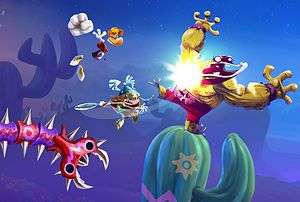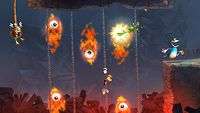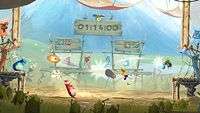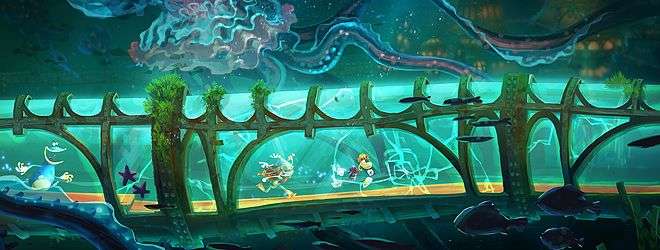Rayman Legends – Review
by Ric

|
 When Rayman Origins launched back in 2011, it showed that even in a world populated by ultra-realistic 3D environments, you could still craft beautiful 2D games that were an absolute blast to play. It was critically acclaimed, and I personally loved every second of it, sharing the entire experience with my girlfriend of the time. But Origins wasn’t exactly a big seller, and things had to change. Rayman Legends was announced as a Wii U exclusive, and is now a multi-platform release. 3D elements have been thrown into the mix. And I’m single and bitter. Can the sequel live up to the stellar quality of the original?
When Rayman Origins launched back in 2011, it showed that even in a world populated by ultra-realistic 3D environments, you could still craft beautiful 2D games that were an absolute blast to play. It was critically acclaimed, and I personally loved every second of it, sharing the entire experience with my girlfriend of the time. But Origins wasn’t exactly a big seller, and things had to change. Rayman Legends was announced as a Wii U exclusive, and is now a multi-platform release. 3D elements have been thrown into the mix. And I’m single and bitter. Can the sequel live up to the stellar quality of the original?
Set a century after the first game, Legends kicks off with our heroes awakening from their one-hundred-year nap to find that the world is once more overrun with nightmares and Darktoons, who have kidnapped princesses and generally just been evil. Once again, it’s up to the limbless wonder, his weird frog-thing friend Globox, and a bunch of Teensies, the world’s adorable inhabitants, many of whom have been locked up by the Darktoons, to save the world. It’s a pretty standard plot for a platformer, but that’s really not what we’re here for. It’s all about how well it plays.
And it plays fantastically. The core mechanics haven’t changed from Origins; you run through a series of wonderful and inventive worlds, jumping and kicking your way past obstacles and enemies to reach the end of the level. There have been some pretty big changes to what you actually do in the levels, however. Instead of rewarding the player with Electoons for collecting a certain amount of Lums in the level, there are now ten Teensies hidden within each level for the player to hunt down and free. The small challenge rooms hidden throughout levels are still there, and are clever as ever, offering a slightly different challenge from the rest of the level.
 Lums are still important to collect, of course, and they’ve received their own little revamp. Instead of picking up a giant Lum, making every basic one worth double for a short amount of time, they now appear in sequences, with the head Lum being worth twice as much as the rest. Picking up that first Lum makes the next worth double, and so on as you move down the chain. Break the chain, however, and the two-times bonus is lost. It forces the player to stop and think about how to collect the Lums, rather than just blasting through them all as fast as possible. You’ll need to think about this as well, since the number required at the end of each level has doubled; while Origins had you seeking out a max of 300 in each level, Legends whacks it up to 600, forcing you to track down every Teensie, Skull Coin (hard-to-get items worth 25 Lums) and double Lum to get the elusive gold trophy.
Lums are still important to collect, of course, and they’ve received their own little revamp. Instead of picking up a giant Lum, making every basic one worth double for a short amount of time, they now appear in sequences, with the head Lum being worth twice as much as the rest. Picking up that first Lum makes the next worth double, and so on as you move down the chain. Break the chain, however, and the two-times bonus is lost. It forces the player to stop and think about how to collect the Lums, rather than just blasting through them all as fast as possible. You’ll need to think about this as well, since the number required at the end of each level has doubled; while Origins had you seeking out a max of 300 in each level, Legends whacks it up to 600, forcing you to track down every Teensie, Skull Coin (hard-to-get items worth 25 Lums) and double Lum to get the elusive gold trophy.
Lums are also the key to unlocking things this time around. Accumulating Lums unlocks extra characters to play as, although these are mostly reskins of current characters and as such don’t add anything new to the experience, but it’s still a nice touch. Gathering three-quarters of the gold trophy target in a level also earns the player a Lucky Ticket, which is basically a scratchcard that guarantees a reward of some kind; either a Teensie, some Lums, a Creature or an old level from Rayman Origins (more on those later). The Creatures are a strange little addition, because they don’t really serve any purpose other than to give you additional Lums and earn you more trophies for completing sets. In fact, the Lucky Tickets are completely redundant because there’s no option of failure, and there’s no other way to unlock those additional Teensies, Creatures or Origins levels. Basically it randomises unlocks and throws in a five second mini-game, but you will unlock everything they offer you if you collect them all. It’s good that you can’t miss the collectibles, but at the same time the whole system feels a little pointless, and could easily have been replaced by straight up unlocking additional content from hitting the requisite Lum-count in a level.
 |
 |
 |
 |
 |
 |
That doesn’t mean Teensies are entirely pointless either, as the more you find, the more levels you unlock. Each world has two doors leading to levels where you rescue the princesses, and also have a certain point at which the rest of the world is locked by a Teensie gate. Weirdly however, you unlock new worlds faster than you do the remaining half of your current world, and this appears to have been done deliberately as the difficulty remains fairly low on early levels in each world. You can quite easily stay on one world, grabbing every Teensie and unlocking all the levels in one run, but that then means that the difficulty is slightly skewed. After ramping up the difficulty in later levels of a world, it’s a little odd that suddenly you’re back to breezing through again, and this happens at the start of every new world. It’s supposed to encourage the player to experience lots of new environments and keep things varied, I suppose, but for completionists like myself it proves to be a totally pointless system.
 The levels themselves are wonderful, however. Each one has clearly had a lot of thought put into it, so that secrets can be tough but not impossible to find, and every section presents a decent challenge without being hideously frustrating. You’ll never die because of a cheap jump or ridiculous AI; it’s always simply because you hadn’t timed the jump right or you were just plain unlucky. The checkpointing system has been overhauled now, so that you’re not forced to restart an entire room as in the original, and in this way is more forgiving, allowing you to pick up where you left off very quickly, and therefore allows for longer levels that flow better, rather than being short rooms separated by doors.
The levels themselves are wonderful, however. Each one has clearly had a lot of thought put into it, so that secrets can be tough but not impossible to find, and every section presents a decent challenge without being hideously frustrating. You’ll never die because of a cheap jump or ridiculous AI; it’s always simply because you hadn’t timed the jump right or you were just plain unlucky. The checkpointing system has been overhauled now, so that you’re not forced to restart an entire room as in the original, and in this way is more forgiving, allowing you to pick up where you left off very quickly, and therefore allows for longer levels that flow better, rather than being short rooms separated by doors.
From time to time you’ll be accompanied by a greenbottle named Murphy, who you’ll need to utilise to get past obstacles that Rayman and co can’t handle themselves. This was initially one of the main draws of the Wii U version, where the player would control Murphy, or another player could use the GamePad to help the main player. On the 360 version, however, Murphy’s skills are relegated to context-sensitive actions triggered by a quick press of B, or sometimes using LB and RB to rotate a wheel. This isn’t a bad system, and actually it adds an extra bit of challenge where the player not only has to focus on keeping their character alive but also making sure the level is set up for them to make the next jump. Murphy can grate a little however; he has a Navi-esque tendency to shout at you when he can perform an action but you’re not activating him, and from time to time will hover over the wrong object because you haven’t reached quite the right place for him to move on. Still, he isn’t present in every level, and for the most part is a good addition rather than a flying annoyance.
Boss battles are back, and better than ever. They’re still as big and nasty as before, but this time, because the checkpointing system is so much better, you’ll no longer be frustrated by having to redo the entire battle over and over as you learn their patterns. That doesn’t mean that they’re any easier, however, and you will still die plenty of times trying to work out the best way to take them on, but it’s still good fun squaring up against them and figuring out how to take on their weak spots. Slightly disappointingly, Tricky Treasure levels have gone, but so have the annoying time trials each level had, and there isn’t a side-scrolling shooter section in sight (in the new content, anyway). Instead, almost every level has an alternate “Invaded” level, which is unlocked as you progress through the game. These levels are intensely difficult, tasking you with running through a mass of obstacles and enemies to reach the end goal in less than a minute, or forty seconds if you’re aiming to save all the Teensies. They’re tricky little additions that don’t take too long to finish, but which add that extra bit of challenge in case the rest of the game is getting too easy for you.
 The newest and best addition to the game is that of the musical levels. After beating the boss in a world, you unlock another level that tasks you with sprinting to the end of the level, while jumping and kicking in time to the music. It’s all a bit HarmoKnight, by which I mean largely unoriginal, but these levels are damn good fun, and the remixed tracks that you play along to are fantastic. Highlights include a rendition of Black Betty that has a cast of enemies jump up and shout “BAM A LAM” at the appropriate point, as well as a fantastic Mariachi cover of Eye Of The Tiger. It’s a great way to finish up a world, and is guaranteed to put a smile on your face.
The newest and best addition to the game is that of the musical levels. After beating the boss in a world, you unlock another level that tasks you with sprinting to the end of the level, while jumping and kicking in time to the music. It’s all a bit HarmoKnight, by which I mean largely unoriginal, but these levels are damn good fun, and the remixed tracks that you play along to are fantastic. Highlights include a rendition of Black Betty that has a cast of enemies jump up and shout “BAM A LAM” at the appropriate point, as well as a fantastic Mariachi cover of Eye Of The Tiger. It’s a great way to finish up a world, and is guaranteed to put a smile on your face.
That is until you unlock the Living Dead Party world. This world sees you re-doing the musical levels, only this time they’ve been re-done as chiptune tracks. Not content with simply remixing the songs, however, Ubisoft have decided to take the visuals back to the early 90s as well, completely messing up your view and making the levels much harder than they should be, and for no good reason. For example, the second remix features a screen effect as if you’re playing on a shoddy old black-and-white TV, complete with the screen completely fuzzing over at certain points and leaving you to either rely on your perfect knowledge of the level, trust in your ability to follow the beat of the song, or simply hope for the best. It’s a cool way of remixing the levels, sure, but it takes all the hard work they put into making the new levels tricky without being cheap, and cheapens them to the point of being plain annoying.
 |
 |
 |
 |
 |
 |
Rather than simply shove in the old levels, the “Back to Origins” levels have been morphed to fit the new gameplay mechanics, so you’ll still be finding ten Teensies and 600 or more Lums in each level, just in a more familiar environment. The levels are as brilliant as they always were, but there are some problems with the way they’re implemented. For starters, the developers have chosen to choose a small selection of the levels and place them in a mixed-up order. This is fine for the most part, but the Tricky Treasures are now no longer optional, and ramp up the difficulty way too high by appearing halfway through the world. It’s really off-putting to be progressing along fine, and then suddenly be faced by a challenge twice as hard as what you’ve been dealing with so far, when you know the next level will be more in line with the difficulty curve. Also, the Origins levels serve as a fantastic reminder that the scrolling-shooter sections are actually pretty awful, as was the checkpointing system, which remains the same for these levels. Their inclusion is much appreciated however, and I enjoyed reliving the old game in a new engine and seeing how much things have improved in the sequel.
 Once you’ve wrapped up the main levels, there’s still more to do. The new Challenge section gives you daily and weekly challenges to tackle, and show off to the world your platforming skills. These are fun little diversions that take as long as you can hold out, and while the rewards are fairly minimal, coming in the form of a thousand Lums or so and a trophy based on your performance, they’re still fun to compete in. There didn’t seem to be much variety on show, sadly, with the same five or six levels being reused over several days with different objectives each time, but that didn’t detract too much from the shot burst of fun they offered. Finally, you and some friends can take part in the Kung Foot mode, a small mini-game that sees you playing a very basic match of violent football. Again, it’s just a tiny diversion from the main game, and not one you’ll spend a lot of time doing, but it is actually a lot of fun and a neat little way of providing competitive multiplayer in a co-operative game.
Once you’ve wrapped up the main levels, there’s still more to do. The new Challenge section gives you daily and weekly challenges to tackle, and show off to the world your platforming skills. These are fun little diversions that take as long as you can hold out, and while the rewards are fairly minimal, coming in the form of a thousand Lums or so and a trophy based on your performance, they’re still fun to compete in. There didn’t seem to be much variety on show, sadly, with the same five or six levels being reused over several days with different objectives each time, but that didn’t detract too much from the shot burst of fun they offered. Finally, you and some friends can take part in the Kung Foot mode, a small mini-game that sees you playing a very basic match of violent football. Again, it’s just a tiny diversion from the main game, and not one you’ll spend a lot of time doing, but it is actually a lot of fun and a neat little way of providing competitive multiplayer in a co-operative game.
Graphically, the Rayman Legends retains its beautiful 2D cartoon style from the first game, but this time around the colours are deeper and darker, with characters receiving more definition and the worlds looking slightly more sinister and unwelcoming than before. It’s a little jarring at first, since the first game was filled with such bright and vibrant colours, but the new style reflects the world very nicely, and there are still plenty of bright colours being thrown in so it’s not all one big murky mess. In a pretty major change, 3D models now make an appearance, with several bosses being gigantic, cartoonish 3D models, and some of the enemies that act as their cronies in pre-boss battle levels are also drawn in this fashion. The 3D models are disappointing in so many ways; they don’t look nearly as crisp and clean as the 2D visuals, and they’re completely pointless since the game operates on a 2D plane anyway. There’s never a section where you’ll be fighting these enemies in 3D environment, and the models just look out of place amongst all the gorgeous 2D graphics. Thankfully, the 3D models are only used in a handful of levels, so they aren’t around for long, but it’s a real shame that the gorgeous art style of the original was changed to fit in these garish, pointless models.
The soundtrack is, as it was in the previous game, phenomenal. The musical levels that I touched on earlier are a clear highlight, but even in the standard levels, the music is beautifully composed, and brings a lot of fun and energy to proceedings. There’s homages to spy soundtracks, soft surf songs to swim around to, and the ukulele returns to bring some childish glee to your life. The sound effects are all still spot on, with a satisfying thwack played as you punch an enemy square in the face, and even the voice acting of the Teensies is plain adorable. It’s stellar work across the board, and I don’t have a single complaint.
 Multiplayer is, of course, a big deal once more in Legends, with up to four people playing together on one screen in drop-in, drop-out co-op. Sadly, I didn’t get much chance to play the game with friends, although I did manage to rope a six-year-old to work through some levels with me to test out the mechanics. The bubble system is still present and correct from the first game, allowing players to be brought back to life by their friend if they succumb to an untimely death, and you can still smack each other about if you feel that your friend’s death is well overdue.
Multiplayer is, of course, a big deal once more in Legends, with up to four people playing together on one screen in drop-in, drop-out co-op. Sadly, I didn’t get much chance to play the game with friends, although I did manage to rope a six-year-old to work through some levels with me to test out the mechanics. The bubble system is still present and correct from the first game, allowing players to be brought back to life by their friend if they succumb to an untimely death, and you can still smack each other about if you feel that your friend’s death is well overdue.
Weirdly, each player has the ability to activate Murphy in levels where he is present, which can lead to humorous situations where players can deliberately get their friends killed by moving a platform at the wrong time. This may seem fun at the time, but could get annoying in the long run if you happen to have a friend with a particular affinity for griefing. Still, the co-op systems are as great as ever, and you’re bound to have even more fun with friends than you will playing it on your own.
 |
 |
 |
 |
 |
 |
Looking back, I can understand where you might think I didn’t really enjoy Rayman Legends, so I’d just like to reinforce something here: it’s seriously good fun. Blasting through levels at high speed, working out the best routes to get the most Lums, squaring off against giant bosses – it has its faults, sure, but at the end of the day it’s just a great laugh. There’s enough little twists in each level to keep them different and varied from one another and, as I said, every level is wonderfully designed. And it’s just plain silly, too. Some enemies require you to get Murphy to tickle them so you can lay the smackdown on them. At the start of two levels you are transformed into a duck. After each boss, you punch a Darktoon so hard he goes flying into a crater on a moon situated in a constellation of a pig, where the moon resides in the pig’s arse. It’s a wonderful game, with beautiful graphics and a great soundtracks. It’s not perfect; what is? But it’s damn close.
Pros- An absolute blast to play, with plenty of variety
- Absolutely stunning 2D graphics
- A fantastic soundtrack bringing plenty of energy
- Clever and challenging, but forgiving enough to not be infuriating
- 3D models feel out of place and aren't as good as the 2D visuals
- The last bunch of levels are cheap and infuriating
- Murphy can be annoying and unresponsive when you really need him to work
Rayman Legends is, hands down, the best platformer there has been in decades. It improves upon the original in so many ways, and adds plenty of new mechanics to make up for ripping out the old ones that weren't that great anyway. It's gorgeous, 3D models aside, and also a treat for the ears. There are things wrong with it, but they don't detract from the fact that it's one of the most fun, humorous and clever games money can buy. Don't let this game fall by the wayside like the original – go buy it. Right now. You won't regret it, trust me.
Last five articles by Ric
- Playing Rhiannon, With Rhiannon
- The Hidden Controversies of 2015
- Best of 2015: Tell No Tales
- Best of 2015: A Good Walk Spoiled By John
- Best of 2015: My Summer As A Drug Dealer


























Ok, so I now need to get this and it’s prequel. I really loved the new Donkey Kong on the Wii. Would you say it’s on par/better than that?